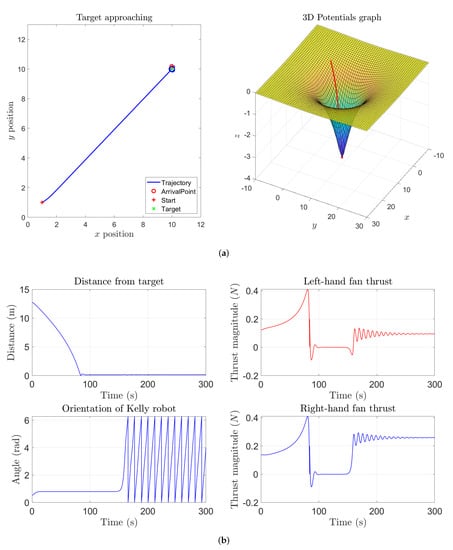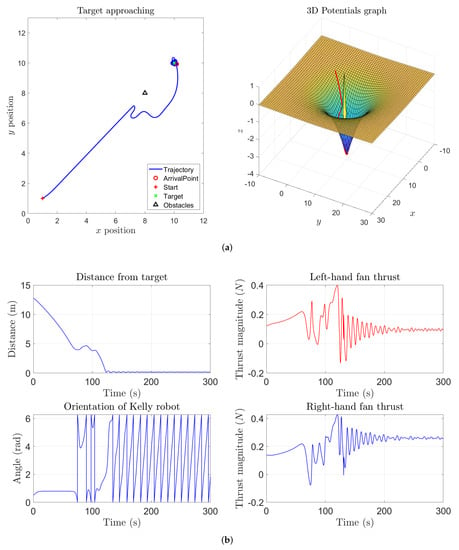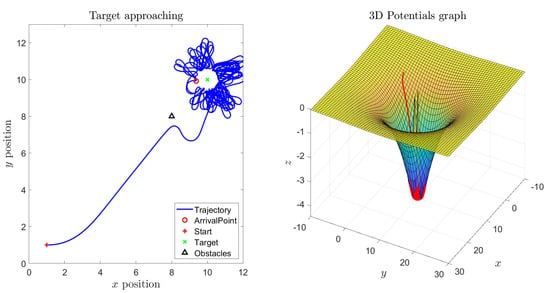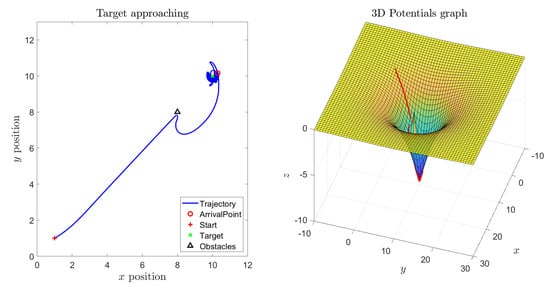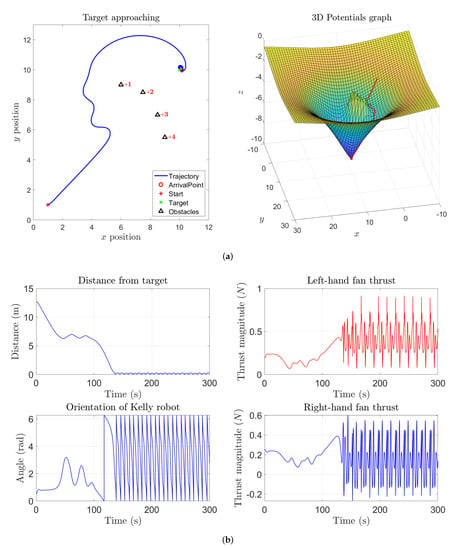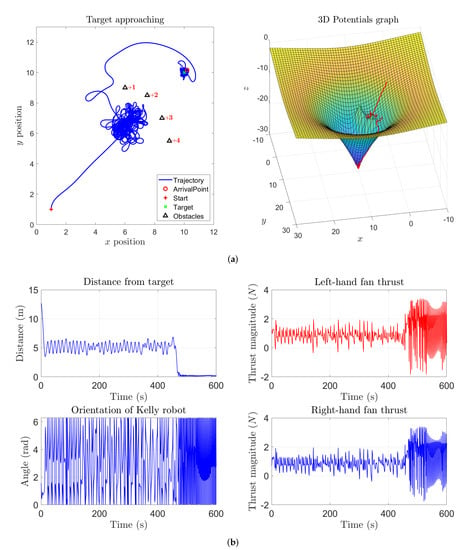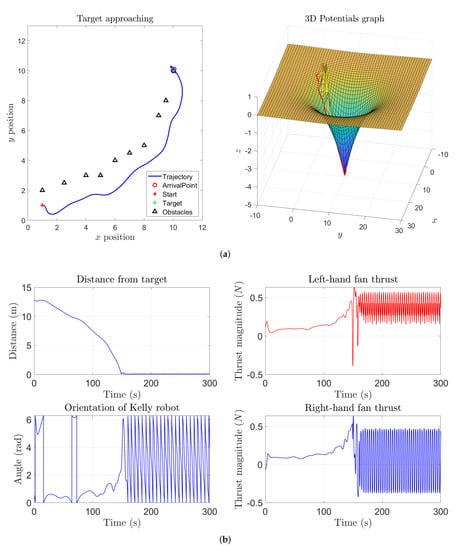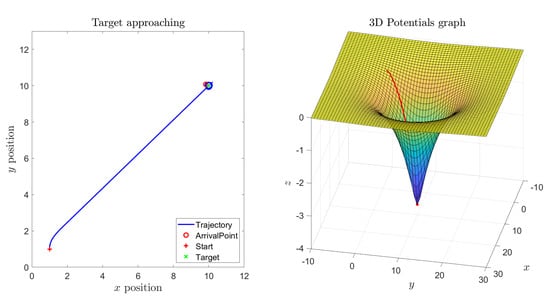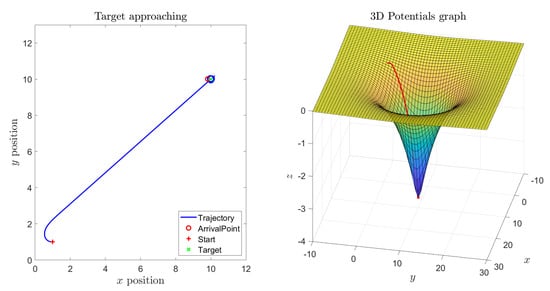Abstract
The present paper is concerned with an instance of automatic control for autonomous vehicles based on the theory of virtual attractive-repulsive potentials (VARP). The first part of this paper presents a review of the VARP control theory as developed specifically by B. Nguyen, Y.-L. Chuang, D. Tung, C. Hsieh, Z. Jin, L. Shi, D. Marthaler, A. Bertozzi and R. Murray, in the paper ‘Virtual attractive-repulsive potentials for cooperative control of second order dynamic vehicles on the Caltech MVWT’, which appeared in the Proceedings of the 2005 American Control Conference, (Portland, OR, USA) held in June 2005 (pp. 1084–1089). The aim of the first part of the present paper is to recall the mathematical and logical steps that lead to controlling an autonomous robot by a VARP-based control theory. The concepts recalled in the first part of the present paper, with special reference to the physical interpretation of the terms in the developed control field, serve as the starting point to develop a more convoluted control theory for (second-order) dynamical systems whose state spaces are (possibly high-dimensional) curved manifolds. The second part of this paper is, in fact, devoted to extending the classical VARP control theory to regulate dynamical systems whose state spaces possess the mathematical structure of smooth manifolds through manifold calculus. Manifold-type state spaces present a high degree of symmetry, due to mutual non-linear constraints between single physical variables. A comprehensive set of numerical experiments complements the review of the VARP theory and the theoretical developments towards its extension to smooth manifolds.
1. Introduction
Most control problems of interest in engineering and applied sciences concern positioning, path planning and obstacles avoidance. A noteworthy example is given by the need of commanding a spacecraft in such a way that it avoids bright objects yet maintaining communication with ground station, as discussed in []. Further noteworthy examples are found in landing maneuvering of manned electric vehicles [], interception of mobile search vehicles [], and manual guidance of robotic manipulators []. Virtual potentials prove effective in solving non-linear control problems as they appear to be versatile and widely applicable. In order to control a particular dynamical system, it is necessary to build a virtual potential field. Such construction may be effected within a number of mathematical frameworks. For instance, a virtual potential field may be constructed by the use of harmonic functions and Laplace’s equations [,], artificial gyroscopic forces [] and stream functions from fluid dynamics [].
The study of potential fields took originally its moves from physics, chemistry and biology [] although its versatility makes it advantageous in several different fields such as vehicle coordination []. In fact, potential fields have been widely used to control different types of vehicles such as cylindrical robots [], helicopters [], road vehicles [] and unmanned ground vehicles [].
A special acknowledgment should be paid to Koditschek and Rimon who, in a series of papers, laid the foundation of the VARP theory. In particular, in the contribution [], the authors proposed “a methodology for exact robot motion planning and control that unifies the purely kinematic path planning problem with the lower level feedback controller design”. The innovative aspect of their work was to encode complete information about a freespace and goal in the form of a special virtual potential function, termed navigation function. Such navigation function gives rise to a feedback controller for the robot that guarantees collision-free motion and convergence to the destination. The authors of [] developed a family of navigation functions that serve to guide a point-mass robot through a generalized sphere world. The simplest member of such family of navigation functions is obtained by puncturing a disk by an arbitrary number of smaller disjoint disks that represent obstacles. More complex spaces (and obstacles) are obtained from this model by suitable coordinate transformations. The study [] was essentially devoted to planar scenarios and appears as an application of more general results presented earlier in [], where the general problem of constructing navigation functions on arbitrary manifolds (not only those obtainable as deformations of sphere words) was dealt with.
Over the years, potential fields have been applied to constrained attitude control, as they enable to handle simultaneously a large number of forbidden and mandatory zones, while guaranteeing computational tractability and convergence []. Potential fields have also been applied to slew maneuver of satellites; see, e.g., the paper [] that introduced a ‘Sun avoidance potential’. The manuscript [] introduced the notion of exponential repulsive potential whose gradient returns a protection control field to prevent aircraft accidents. The contribution [] utilizes virtual potential functions to generate trajectories to be used as initial guesses for a ‘general pseudospectral optimal control’ algorithm. The research work published in [] presents a real-time hybrid guidance method which fuses the flexibility and robustness of harmonic potential functions with a rapidly-expanding random-tree method; such research outcome allows to plan near-fuel-optimal trajectories on cluttered environments. The paper [] outlines a method based on the theory of virtual potential fields combined with sliding mode control for spacecraft maneuvers in the presence of obstacles; guidance and control algorithms devised in such manner were validated through a six degree-of-freedom omorbital simulator. Guidance algorithms based on artificial potential functions play an increasingly important role in hazard avoidance, although local minima might cause a spacecraft to be unable to reach the desired target landing point in complex terrains. In the paper [], a novel hazard avoidance guidance method was developed by improving the traditional virtual potential function structure.
Potential fields may also be utilized in conjunction with other control strategies. For example, Cao et al. [] suggested using potential fields in order to adjust the path planned by a neural network in such a way that an autonomous underwater vehicle avoids obstacles. Baxter et al. [] developed a control method based on the exchange of information regarding potential fields between robots belonging to the same local group of vehicles. Huang [] proposed a path and speed planning strategy based on the use of a potential field for a robot located in a dynamic environment where obstacles and targets are moving.
Potential function-based proportional-derivative as well as augmented-proportional-derivative control laws were developed in [] to govern the motion of an underactuated autonomous underwater vehicle in an obstacle-rich environment; for obstacle avoidance, a mathematical potential function was devised, which formulates the repulsive force between the vehicle and the solid obstacles intersecting a vehicle’s desired path. The guidance and control framework proposed in [] integrates offline optimal path planning with a safety distance constrained A* algorithm, and an online extended adaptively-weighted virtual potential field-based path following approach with dynamic collision avoidance, based on unmanned surface vehicles maneuvering response times. An adaptive potential function approach originally developed for ground robots was modified in [] and employed as a guidance law for a class of rotary-wing unmanned aerial vehicles that must also avoid obstacles located in a three-dimensional workspace.
The use of potential fields has been extensively studied and some alternatives have been proposed to overcome those difficulties that it might entail. An often encountered difficulty is that a local minimum in the potential field might trap a controlled vehicle and consequently prevent it from reaching the global minimum, which represents the actual goal. Lee et al. [] proposed a solution to such problem based on the placement of a virtual repulsive obstacle in a local minimum to keep a robot adequately distant from it. A further solution to the aforementioned problem is to invoke hybrid strategies based on virtual potentials and BUG algorithms [,,,,], as proposed by Wang et al. []. A further common difficulty to be aware of in the use of potential fields is the oscillation of the controlled vehicle around obstacles and targets. Several proposals have been presented to address such problem. Ren et al. [] proposed the use of a modified Newton’s method (MNM) for robot navigation based on an approximation of a potential field function, which is often a complicated non-linear function, by a quadratic form. Li et al. [] presented a regression search method, based on an improved artificial potential field, capable of mitigating local minima as well as oscillations. Such solution consists in redefining potential functions in order to delete local minima and in utilizing virtual local targets for a robot to escape oscillations. Regression search was then used to optimize the path followed by a vehicle.
On the basis of the consistent literature accumulated on this subject, the authors of [] proposed a workable feedback control theory, termed VARP (that stands for virtual attractive-repulsive potentials) that they applied to drive a simple robotic platform (named ‘Kelly robot’). The control algorithm developed by the authors Nguyen, Chuang, Tung, Hsieh, Jin, Shi, Marthaler, Bertozzi and Murray was proven effective through experiments conducted at the Caltech University’s multi-vehicle wireless testbed facility. One of the main ideas developed in the paper [] was to endow each element in the environment, including the controlled robot as well as obstacles and targets, by both an attractive and a repulsive potential to improve maneuverability and control flexibility.
Since such VARP control theory was specifically designed to control a simple robotic platform with three degrees of freedom (two positional coordinates and an orientation angle), it cannot be extended directly to more complicated dynamical systems such as a six degree-of-freedom drone. The aim of the present paper is to design an artificial control field based on the virtual attractive-repulsive potentials to be applied to a wide class of dynamical systems. In fact, in the present paper, a VARP-based method will be developed to control different dynamical systems whose state-space equations insist on different mathematical spaces. In particular, manifold-type state spaces shall be dealt with, which present a high degree of symmetry, due to mutual non-linear constraints that single physical descriptive variables are subjected to. In order to formulate a VARP-on-manifold control theory, a special branch of mathematics will be accessed, namely manifold calculus. In addition, in order to implement the devised VARP-on-manifold control theory on a computing platform, specific numerical algorithms have been developed, which are based on manifold calculus. As a reference on coordinate-free (embedded) manifold calculus in system theory and control, interested readers might consult the tutorial paper [].
The present document is organized as follows.
Section 2 describes the theory of virtual attractive-repulsive potentials as introduced in [,]. The aim of this section is to recall the main concepts related to the VARP theory and its main theoretical features.
Section 3 presents a description of a prototypical wheeled robot, used at the Caltech University for testing the devised VARP principle. This section also explains how to implement the VARP control method on a computation platform in order to evaluate numerically its effectiveness in controlling a small robot. In particular, in this section, results of numerical experiments obtained by varying the parameters of the VARP method will be presented and discussed, in order to illustrate its features. The numerical experiments were performed on purpose by a low-precision numerical scheme (the forward Euler method) to recap this method that will be extended to manifold in the following section. The analysis presented in this section is propaedeutic to the following development as the understanding of details concerning the application of the VARP control theory to drive a small robot will be beneficial in extending the VARP theory to control more complicated systems whose state evolves on smooth manifolds.
Section 4 recalls generalities of Riemannian manifolds and recaps the theory of second-order dynamical system whose state equations are formulated on the tangent bundle of a manifold. This section then illustrates how the VARP method can be extended in order to control a dynamical system whose state equations are formulated on a Riemannian manifold (M-VARP). As a case-study, the M-VARP method will be illustrated on the manifold (a three-dimensional unit sphere). The numerical algorithms to implement such control scheme will be shown to arise from a specifically-tailored version of a forward Euler method on manifolds.
Section 5 completes the present document, focusing on conclusions and future works.
2. Introduction to the VARP Control Theory
The virtual attractive-repulsive potentials-based control theory stems from the construction of a virtual potential field made of virtual points. To each point it will be assigned both an attractive and a repulsive potential. The points on the virtual field may represent obstacles, targets or different sorts of objects in a state space. In this document, we shall recall how the VARP control theory may be employed to control different dynamical systems associated to different state spaces.
2.1. Virtual Potentials for Swarming Models in Biology
Virtual potentials provide a convenient framework for autonomous vehicle control and path planning. Such potentials arise from swarming models in biology and may be formulated as in the discrete particle model proposed by the Levine-Rappel-Cohen group [].
Given N particles labeled , the model proposed in [] that governs the motion of each particle is described by:
where denotes the mass of each particle, and its position and velocity, respectively. Each particle experiences a unit-norm self-propelling force with fixed magnitude . To prevent the particles from reaching large speeds, a friction force with coefficient was introduced.
In addition, each particle is subjected to an attraction force (that depends only on the distance from one particle to the others) which is characterized by an interaction range . This force is responsible for the aggregation of the particles. To prevent a collapse of the aggregate, a shorter-range repulsive force was introduced with interaction range . The authors of [] verified experimentally that qualitative results are independent of the explicit expression of the interaction potential. Levine’s model is, in fact, based on exponentially decaying interactions described by virtual potentials of the kind:
where , determine the strength of the attractive and repulsive forces, respectively. (The original potential has reversed sign with respect to the one reported here: We have chosen the above form for consistency with the remainder of the paper.) We underline that Levine’s model is based on parameters whose values are identical for each particle, while in the next sections we shall define specific parameters for each obstacle and target.
2.2. VARP Control Theory
From Levine’s model, a VARP theory to control and coordinate a group of vehicles was developed in []. Given an i-th vehicle and N concurrent agents labeled , the VARP control method is described by the following general coupled equations:
where the notation used has the following meaning:
- the symbol denotes a unit vector in a reference frame attached to each i-th vehicle rotated with respect to the inertial reference frame by an angle , as illustrated in Figure 1;
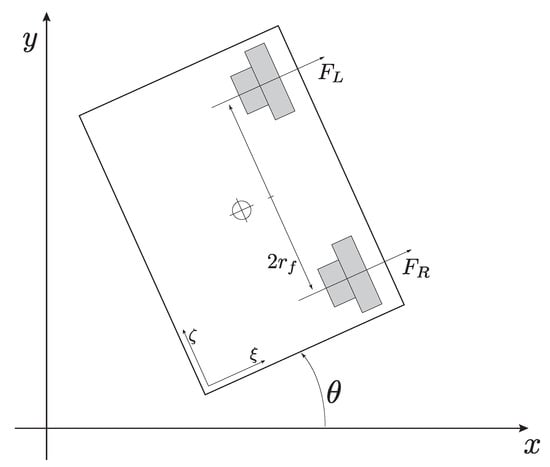 Figure 1. Schematic of Kelly robot’s geometry and of the reference systems used to model its dynamics, as well as of the thrusts acting on Kelly robot’s body as generated by the fan-type propellers.
Figure 1. Schematic of Kelly robot’s geometry and of the reference systems used to model its dynamics, as well as of the thrusts acting on Kelly robot’s body as generated by the fan-type propellers. - the symbol denotes the position of the i-th vehicle at time t;
- the symbol denotes the velocity of the i-th vehicle at time t;
- the constant denotes the mass of the i-th vehicle;
- the quantity denotes the Euclidean distance between the i-th vehicle and the j-th agent that is located at at time t; in this context, an agent could represent an obstacle, a target point or another vehicle; in the case of multiple vehicle control, each vehicle other than the i-th one will be considered as an obstacle for the i-th vehicle, therefore the position of the i-th vehicle is denoted as while the position of the j-th obstacle will be denoted as ;
- the constant denotes the magnitude of the self-propelling force; the self-propelling term determines a speed-up of the motion of a vehicle and helps escaping unwanted plateaus of the potential function; the amplitude of the self-propelling term modulates these positive effects but may also cause instability in the system and unwanted oscillations around the way-point;
- the constant denotes a friction coefficient; viscous-type friction brakes the motion of a vehicle and generally has the positive effect of stabilizing its motion; friction has however the side effect of slowing down the navigation of a vehicle; the friction coefficient should hence be chosen sufficiently large to stabilize the system and sufficiently small not to delay excessively reaching the way-point;
- symbols e denote, respectively, the attractive and repulsive potential functions, defined as:where constants , denote the “magnitude of the potentials”, constants , their “characteristic lengths”, and denotes a real positive variable.
In the biology-inspired model proposed in [], potentials serve to organize a group of self-propelled particles into a mill-like formation. In the VARP theory, attractive potentials are used to direct vehicles towards way points and attractive/repulsive potentials to keep vehicles avoiding each other and stationary obstacles. Namely, a point-to-point control strategy arises from the VARP theory.
4. Extension of the VARP Control Theory to Riemannian Manifolds
The aim of the present section is to design a VARP-like principle to control second-order dynamical systems whose state space is a Riemannian manifold. This method will be referred to as M-VARP as it represents an extension of the original VARP control method to a generic Riemannian manifold.
A number of real-world dynamical systems may be framed as systems on manifolds. An example is a flying drone or an orbital gyrostat whose attitude is represented by a special orthogonal matrix belonging to a manifold denoted as SO(3) as illustrated, for example, in [,,].
Successively, the devised M-VARP principle will be implemented and simulated for the case of study where it controls an abstract dynamical system whose state space is the sphere (which will be denoted as -VARP). As in the previous experiments, we shall consider the presence of a single agent (as a matter of fact, in this paper we do not deal with ‘cooperative control’). As a general reference to manifold calculus, interested readers might want to refer to the Symmetry tutorial paper [].
4.1. Generalities on Riemannian Manifolds
Let denote a smooth manifold. At a point , the tangent space to the manifold is denoted as . The symbol denotes the tangent bundle associated to the manifold defined as .
A Riemannian manifold is endowed with a bilinear, positive-definite form that associates a scalar (or inner) product to each tangent space . A local metric also defines a local norm , for .
The Riemannian gradient of a scalar-valued function evaluated at a point is denoted as . The Riemannian gradient is associated to a specific metric.
A manifold exponential map maps a pair to a point on the manifold. The exponential map ‘shifts’ a point x along a geodesic curve in the direction of v to get to the point y. Its inverse ‘log’ is defined only locally and is termed manifold logarithm. Given points , a manifold logarithm computes a tangent vector such that .
Given two points connectable by a geodesic arc, their Riemannian distance is denoted by . On a Riemannian manifold, the distance between two nearby points may be evaluated by:
A fundamental result of the calculus on manifolds states that the Riemannian gradient of a squared distance function reads:
wherever the logarithm is defined (for a proof, see, e.g., []).
The covariant derivative, a generalization of directional derivative of calculus, of a vector field in the direction of a vector is denoted as . We assume to be endowed with a metric connection (namely, that the covariant derivative of the metric tensor is identically zero).
The parallel transport operator maps a tangent vector at a given point into a tangent vector at another given point , which is denoted as . Parallel transport moves the tangent vector v from to along the geodesic curve that connects the point x to the point y (if any) preserving its tangency along the geodesic arc and the angle formed to the tangent to the geodesic, in such a way to realize a conformal isometry.
Parallel transport and covariant derivation are closely related to one another, in particular, covariant derivation may be expressed in terms of parallel transport as follows:
where denotes any smooth curve with prescribed foot-point and direction, namely such that and . For practical/computational purposes, such smooth curve is often taken as a geodesic arc. Such relationship leads to a numerical approximation of the covariant derivative at a point x, as it will be pointed out in Section 4.3.
4.2. Extension of the VARP Principle to Riemannian Manifolds
In order to extend the VARP principle to control dynamical systems whose state spaces are Riemannian manifolds, it is necessary to recall a fairly broad class of second-order dynamical systems. In the present context, it is sufficient to take into account a class of second-order dynamical systems whose state-transition equations are formulated on the tangent bundle of a manifold , described by:
In such equations, the following notation has been used:
- the function denotes the state of the dynamical system (it could be thought of as the position of a pointwise mass on the manifold at time t);
- the function denotes the tangent vector to the trajectory at the time t (it could be thought of as the velocity of a pointwise mass on the manifold);
- the vector field represents the covariant derivative of the vector field v with respect to itself (it could be thought of as the acceleration of the pointwise mass on the manifold); if the acceleration is zero, thus the pointwise mass will follow a uniform geodesic trajectory (which represents the counterpart, in the ordinary space, of a straight uniform motion);
- the constant denotes a ‘viscous’ friction coefficient (therefore, the term could be thought of as a friction force which brakes the motion of a pointwise mass sliding over the manifold);
- the function denotes a control action at time t (it could be thought of as a force whose purpose is to make a pointwise mass move on a manifold and deviate with respect to a purely geodesic trajectory); such control action is a vector field which is tangent to the manifold at the state .
On the basis of the above formulation of a dynamical system on manifold, it is viable to extend the VARP control principle recalled in Section 2. In fact, an extension to manifold-type state-space systems of the type (36) consists in setting the control action u according to a manifold-consistent translation of the terms in the VARP principle (3). The proposed extension is outlined in the following:
The terms appearing in the above equations may be explained as follows:
- the term , with , represents a self-propelling term, where if otherwise ;
- the function denotes the total potential which depends on the state x; the functions and denote, respectively, the repulsive and attractive components of the potential function, as they were already defined for Euclidean spaces in Section 2.2; note that the components are indexed by the index j: this indexing does not appear explicitly in [] while, in the present case, each obstacle and target has its own coefficient;
- the N terms labeled represent obstacle-associated and target-associated locations on the manifold ;
- the function denotes the squared Riemannian distance between two points on the state manifold ; notice that, in the equations, it appears squared because such choice, generally, simplifies the calculation of derivatives.
Combining together the Equations (36) and (37), it can be readily seen that the control field u takes the expression:
Recalling the relationship (34) for Riemannian manifolds leads to the expression:
where and .
Coherently with what was expected, the results show that .
In analogy to the VARP principle formulated on Euclidean spaces (see Equation (4)), exponential-type attractive and repulsive potential functions have been chosen as:
where and denote the ‘magnitude of the potentials’, and their ‘characteristic lengths’ and denotes a real positive variable. Their derivatives with respect to take the expressions:
therefore the control field (39) ultimately reads:
The M-VARP-controlled dynamical system (in analogy to a VARP-controlled Kelly robot described in Section 3.2) is hence described by the following system of equations:
The first equation governs the evolution of the state x of the dynamical system on the basis of its (tangent) velocity v, while the second equation governs the evolution of the velocity on the basis of the chosen potentials, of the state and of the state-velocity itself. Notice that again all the obstacles located in have been supposed to be stationary, although this is not a strict requirement for the devised theory to hold.
4.3. Extended Euler Scheme for the Numerical Simulation of the M-VARP Control Method
In the preset subsection, we shall illustrate an extension of the previously-recalled forward Euler method to numerically simulate a controlled system on manifold.
The system (43) to be simulated numerically may be recast in compact form as:
where is the function on the right-hand side of the second equation in (43) that maps a point x and a tangent vector into a tangent vector in .
To solve numerically the system of differential Equation (44), namely to simulate the controlled system (43), we introduce three discrete-time sequences that arise from time discretization with a step size :
- the sequence , with , represents a time-discretized version of the state , namely denotes a numerical approximation of the exact state ;
- the sequence , with , represents a time-discretized version of the velocity , namely denotes a numerical approximation of the exact state-velocity ;
- the sequence , with , represents a time-discretized version of the control field , namely denotes a numerical approximation of , that is:
Notice that the discrete-time index is denoted by a superscript () to avoid confusing it with the obstacle/target index which is denoted by subscript (). Once a time discretization of the variables that describe the state of a dynamical system has been performed, an extension of the forward Euler method (fEul) to manifolds may be devised. To express such fEul-like method, the exponential map and the parallel transport operators recalled in Section 4.1 shall be invoked.
As a further consideration that motivates the usage of a simple numerical scheme, such as the forward Euler one, when more precise schemes are available (such as the ones in the Runge–Kutta class), we notice that such higher-order schemes would require evaluating the control field in points of the trajectory that are not available within the numerical schemes, hence causing additional computational efforts and accumulation of additional numerical errors.
It is important to remind that the parallel transport operator is fundamental in the calculation of the covariant derivative. Let us denote by a vector field on (in each point x of the manifold, defines a tangent vector at x) of which the covariant derivative is sought, and by another vector field along which such covariant derivative needs to be calculated. The sought covariant derivative is then defined as:
Indeed, the covariant derivative represents the rate of change of the vector field w along the direction prescribed by the vector field v, namely, moving away from x toward a direction v.
Let us consider numerical resolution of the first equation in (44) that is:
which is an IVP on the tangent bundle . An algorithm that implements the numerical solution in a fEul-like fashion reads:
with and known from the initial conditions.
Let us consider now numerical resolution of the second equation of (44), that is:
which represents a further IVP on the tangent bundle .
The relation (46), applied to the vector field v with respect to itself, could be numerically approximated as:
(We notice that the above relationship is somewhat arbitrary, albeit natural. In fact, the quantities and are not related to the quantities and as much as in the exact relationship (46) and, in particular, are not related to h by a straighforward relationsip, hence the division by h may appear somewhat arbitrary.) Therefore, an algorithm that implements the numerical solution of (49) in a fEul-like fashion reads:
with and known from the initial conditions.
In summary, the numerical iteration that will be made use of in order to simulate a controlled second-order system on manifold reads:
with and known from the initial conditions.
In the following section, numerical results will illustrate a number of features of the devised control strategy on manifold, with reference to the unit hyper-sphere as exemplary case. Let us recall that, in the case of hyper-sphere (), the canonical operators and the Riemannian distance required for the numerical implementation take the following expressions:
The expression given about the logarithmic map is continuous in , in fact it is easily seen that:
In the expression of parallel transport, it is understood that points x and y need not be antipodal, namely .
4.4. Simulations Results about the -VARP Method
In the present subsection, results of numerical simulations will be reported in order to illustrate salient features of the M-VARP control method on the unitary sphere . The values of the parameters displayed in the figure captions were determined on the basis of a trial-and-error procedure, since the non-linear control algorithm is not prone to theoretical determination of optimal coefficients in any analytic way. Notice that in an abstract system the ‘temporal’ parameter t is immaterial, hence the duration of each numerical simulation is expressed in terms of computing steps. The value of the chosen numerical stepsize in every simulation in this section is (s).
The first five numerical simulation results concern a case study where a single target is present while no obstacles were placed over the sphere. Figure 15a shows the state trajectory followed by an abstract second-order dynamical system on the sphere and, as expected, the system state reaches the prescribed target. Across the following subfigures, the self-propelling coefficient was gradually increased, which explains why the system gradually follows a wider path, as illustrated in Figure 15b,c. With an higher value of the coefficient , self-propulsion is stronger than the attractive influence of the target, hence the system state will wander around the sphere without ever reaching the target, as displayed in Figure 15d. However, by increasing the attractive magnitude of the target (), the attractive potential is able to counteract the self-propelling term in order to make the system state reach the target again, as shown in Figure 16.

Figure 15.
Experiment by the -VARP method: Single target, no obstacles. Simulation parameters: , , , . (a) Parameter . steps = 500; (b) parameter . steps = 500; (c) parameter , steps = 500; (d) parameter , steps = 5000.
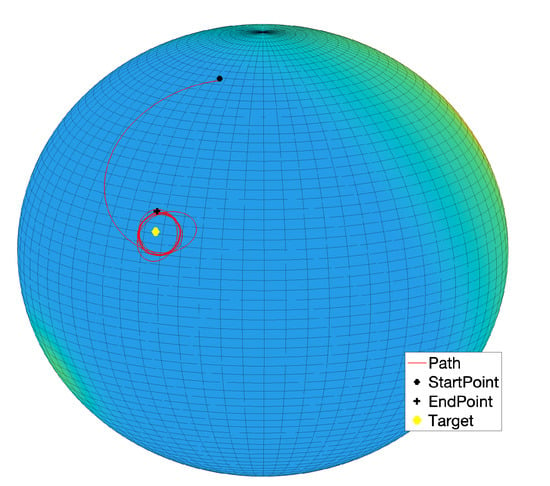
Figure 16.
Experiment by the -VARP method: Single target, no obstacles. Simulation parameters: , . Steps = 500.
A further set of experiments were designed that include one obstacle between the start location and the target location. The state trajectory of the system looks interesting, and aligned to the corresponding behavior seen in Section 3. In fact, the state trajectory of the system at the beginning of the simulation takes the shortest path to reach the target but, when the state gets close enough to the obstacle, it gets repelled and takes a detour to reach the target. As soon as the system approaches the target, its state trajectory reveals an interesting aspect of the VARP control method: since each location in the virtual potential field (that could represent an obstacle or a target) may be associated with both an attractive and a repulsive action, the system will not turn around the target since it is repelled by both the target and the obstacle, as illustrated in Figure 17. Reducing the magnitude of the repulsive potential of the target and of the obstacle, the system state would keep go round the target as shown in Figure 18. From such simulation, we can also notice that, before being repelled, the system state comes closer to the obstacle since its repulsive action was diminished.

Figure 17.
Experiment by the -VARP method: Target and one obstacle. Simulation parameters: , , (where stands for Target and stands for Obstacle).
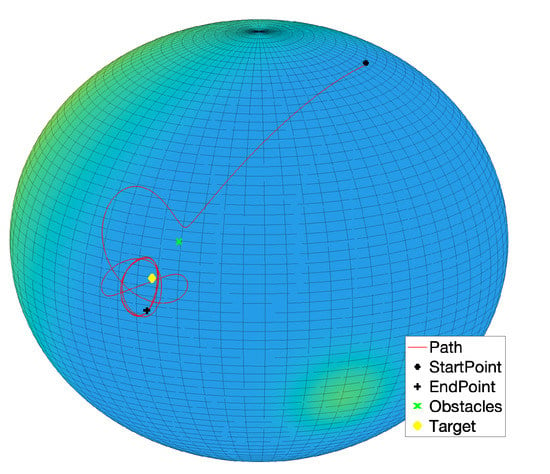
Figure 18.
Experiment by the -VARP method: Target and one obstacle. Simulation parameters: , , (where stands for Target and stands for Obstacle).
Setting suitable parameters values, the controlled system is able to reach the target also in the presence of two (or more) obstacles, by avoiding the virtual potential bump, as illustrated in Figure 19.
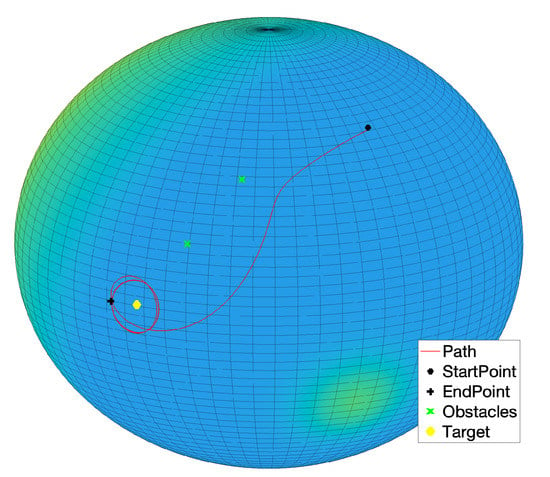
Figure 19.
Experiment by the -VARP method: Target and two obstacles. Simulation parameters: , , (where stands for Target and stands for Obstacle).
Even in the present set of experiments concerning the M-VARP control method, it is interesting to observe how the controlled system behaves when a barrier made of pointwise obstacles is placed between the starting location and the target. Figure 20a illustrates how the controlled dynamical system is able to get around a barrier in order to reach the target. From this figure it is readily appreciated how the controlled agent is unable to get close to the target since the range of influence of the obstacles and their repulsive potentials exert a strong action. By setting lower values for both the repulsive range parameter and the repulsive magnitude of the obstacles makes the controlled system get closer and turn around the target, as illustrated in Figure 20b.
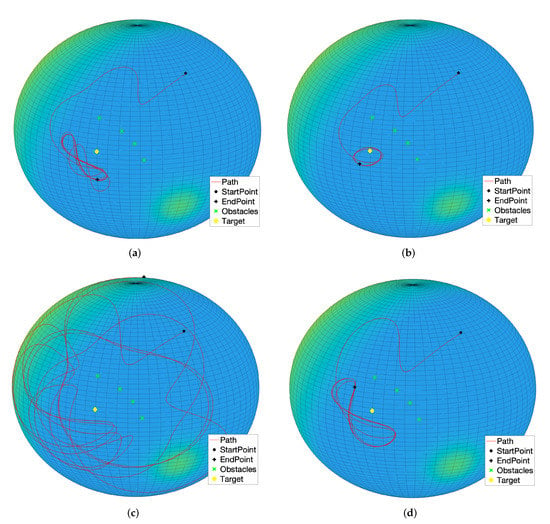
Figure 20.
Experiment by the -VARP method: Potential wall (or ‘barrier’). (In the subcaptions, superscript stands for Target while superscript stands for Obstacle). (a) Parameters: , , , ; (b) parameters: , , ; (c) parameters: , , , ; (d) parameters: , , , .
By increasing both the repulsive strength of the obstacles and the self-propelling coefficient, the system will loose control and will start a rapid oscillatory behavior around the barrier and the target, as it can be observed from Figure 20c. It is interesting to notice that, despite the system propulsion induced by the self-propelling term is way stronger than necessary and the system’s state wanders all over the sphere, yet the agent will never hit the barrier. To make the trajectory smoother and bound to the target, it pays to set a higher attractive magnitude for the target in order to counteract the self-propelling term. Such a conclusion may be drawn by observing the simulation result presented in the Figure 20d.
5. Conclusions and Future Work
The VARP theory developed in [] was originally designed to control a dynamical system whose state equations were formulated on a Euclidean space. The first part of the present contribution aimed at presenting a review of such an instance of VARP control methods as well as a comprehensive set of numerical experiments to illustrate its features in controlling a simple robot with three degrees of freedom. A limited portion of such review was devoted to recall a numerical method to simulate a controlled system as well as to implement the VARP control method on a computing platform.
Based on the understanding acquired on the VARP theory and on its numerical implementation, the second part of the present paper introduced an extension of the VARP control method to regulate the dynamics of second-order systems whose state space takes the form of Riemannian manifolds. Extensive numerical experiments conducted on the manifold proved the effectiveness of the introduced M-VARP theory to control the motion of a dynamical system presenting holonomic constraints in its state-variables. Besides of the present proof-of-concept, applications of the devised theory to realistic engineering cases are currently being pursued.
From a methodological viewpoint, the encouraging results displayed within the present paper suggest a number of further investigations, which are briefly outlined in the following:
- the control method termed M-VARP has been shown effective through numerical experiments; it would be interesting to conduct a theoretical analysis (i.e., Lyapunov-like) about its effectiveness and about its applicability;
- the displayed experiments confirmed that the construction of a potential barrier represents a viable method to guide a dynamical system toward a predefined target; the notion of potential barrier might be extended by the notion of potential corridor that might afford better control of a systems’ trajectory;
- the original VARP control theory was developed to achieve cooperative control; such important feature has not been exploited in the present study, since it has been assumed the presence of a single controlled agent; nevertheless, the M-VARP theory itself inherits cooperative control ability from the VARP method; it would hence be interesting to apply the M-VARP method in a multi-agent environment;
- the M-VARP theory holds in general for Riemannian manifolds and might therefore be applied seamlessly to Lie groups; such observation implies that the devised M-VARP control theory may be applied to complex systems presenting a roto-translational dynamics, such as quadcopter drones.
Such interesting research challenges might be tackled in forthcoming endeavors.
Author Contributions
Conceptualization, L.B., F.P. and S.F.; writing—original draft preparation, L.B., F.P. and S.F.; writing—review and editing, S.F.; supervision, S.F. All authors have read and agreed to the published version of the manuscript.
Funding
This research received no external funding.
Institutional Review Board Statement
Not applicable.
Informed Consent Statement
Not applicable.
Acknowledgments
The authors would like to gratefully thank Toshihisa Tanaka (TUAT—Tokyo University of Agriculture and Technology) for having hosted the authors L.B. and F.P. during an internship in January–March 2020 and for having invited the author S.F. as a visiting professor at the TUAT in February–March 2020.
Conflicts of Interest
The authors declare no conflict of interest.
References
- Hablani, H.B. Attitude commands avoiding bright objects and maintaining communication with ground station. J. Guid. Control. Dyn. 1999, 22, 759–767. [Google Scholar] [CrossRef]
- Wang, Z.; Mao, S.; Gong, Z.; Zhang, C.; He, J. Energy efficiency enhanced landing strategy for manned eVTOLs using L1 adaptive control. Symmetry 2021, 13, 2125. [Google Scholar] [CrossRef]
- Galyaev, A.A.; Lysenko, P.V.; Rubinovich, E.Y. Optimal stochastic control in the interception problem of a randomly tacking vehicle. Mathematics 2021, 9, 2386. [Google Scholar] [CrossRef]
- Reyes-Uquillas, D.; Hsiao, T. Compliant human–robot collaboration with accurate path-tracking ability for a robot manipulator. Appl. Sci. 2021, 11, 5914. [Google Scholar] [CrossRef]
- Connolly, C.; Grupen, R. The application of harmonic functions to robotics. J. Robot. Syst. 1993, 10, 931–946. [Google Scholar] [CrossRef] [Green Version]
- Connolly, C.I.; Burns, J.B.; Weiss, R. Path planning using Laplace’s equation. In Proceedings of the IEEE International Conference on Robotics and Automation, Sacramento, CA, USA, 13–18 May 1990; Volume 3, pp. 2102–2106. [Google Scholar]
- Chang, D.; Shadden, S.; Marsden, J.; Olfati-Saber, R. Collision Avoidance for Multiple Agent Systems. In Proceedings of the 42nd IEEE Conference on Decision and Control, Maui, HI, USA, 9–12 December 2003; pp. 539–543. [Google Scholar]
- Waydo, S.; Murray, R.M. Vehicle motion planning using stream functions. In Proceedings of the IEEE International Conference on Robotics and Automation, Taipei, Taiwan, 14–19 September 2003; Volume 2, pp. 2484–2491. [Google Scholar]
- Levine, H.; Rappel, W.J.; Cohen, I. Self-organization in systems of self-propelled particles. Phys. Rev. E 2000, 63, 017101. [Google Scholar] [CrossRef] [Green Version]
- Leonard, E.; Fiorelli, E. Virtual Leaders, Artificial Potentials and Coordinated Control of Groups. In Proceedings of the 40th IEEE Conference on Decision and Control, Orlando, FL, USA, 4–7 December 2001; pp. 2968–2973. [Google Scholar]
- Chen, Y.B.; Luo, G.C.; Mei, Y.S.; Yu, J.Q.; Su, X.L. UAV path planning using artificial potential field method updated by optimal control theory. Int. J. Syst. Sci. 2016, 47, 1407–1420. [Google Scholar] [CrossRef]
- Paul, T.; Krogstad, T.R.; Gravdahl, J.T. Modelling of UAV formation flight using 3D potential field. Simul. Model. Pract. Theory 2008, 16, 1453–1462. [Google Scholar] [CrossRef]
- Rasekhipour, Y.; Khajepour, A.; Chen, S.; Litkouhi, B. A Potential Field-Based Model Predictive Path-Planning Controller for Autonomous Road Vehicles. IEEE Trans. Intell. Transp. Syst. 2017, 18, 1255–1267. [Google Scholar] [CrossRef]
- Shimoda, S.; Kuroda, Y.; Iagnemma, K. Potential Field Navigation of High Speed Unmanned Ground Vehicles on Uneven Terrain. In Proceedings of the 2005 IEEE International Conference on Robotics and Automation, Barcelona, Spain, 18–22 April 2005; pp. 2828–2833. [Google Scholar] [CrossRef] [Green Version]
- Rimon, E.; Koditschek, D. Exact robot navigation using artificial potential functions. IEEE Trans. Robot. Autom. 1992, 8, 501–518. [Google Scholar] [CrossRef] [Green Version]
- Koditschek, D.; Rimon, E. Robot navigation functions on manifolds with boundary. Adv. Appl. Math. 1990, 11, 412–442. [Google Scholar] [CrossRef] [Green Version]
- Lee, U.; Mesbahi, M. Feedback control for spacecraft reorientation under attitude constraints via convex potentials. IEEE Trans. Aerosp. Electron. Syst. 2014, 50, 2578–2592. [Google Scholar] [CrossRef]
- McInnes, C.R. Large angle slew maneuvers with autonomous sun vector avoidance. J. Guid. Control. Dyn. 1994, 17, 875–877. [Google Scholar] [CrossRef]
- Sun, D.; Hovakimyan, N.; Jafarnejadsani, H. Design of command limiting control law using exponential potential functions. J. Guid. Control. Dyn. 2021, 44, 441–448. [Google Scholar] [CrossRef]
- Gaudet, B.; Linares, R.; Furfaro, R. Spacecraft rendezvous guidance in cluttered environments via artificial potential functions and reinforcement learning. In Proceedings of the AAS/AIAA Astrodynamics Specialist Conference, Snowbird, UT, USA, 19–23 August 2018; pp. 813–827. [Google Scholar]
- Zappulla, R.I.; Virgili-Llop, J.; Romano, M. Near-optimal real-time spacecraft guidance and control using harmonic potential functions and a modified RRT. In Proceedings of the 27th AAS/AIAA Spaceflight Mechanics Meeting, San Antonio, TX, USA, 5–9 February 2017. [Google Scholar]
- Bloise, N.; Capello, E.; Dentis, M.; Punta, E. Obstacle avoidance with potential field applied to a rendezvous maneuver. Appl. Sci. 2017, 7, 1042. [Google Scholar] [CrossRef] [Green Version]
- Zhu, S.; Yang, H.; Cui, P.; Xu, R.; Liang, Z. Anti-collision zone division based hazard avoidance guidance for asteroid landing with constant thrust. Acta Astronaut. 2022, 190, 377–387. [Google Scholar] [CrossRef]
- Cao, X.; Chen, L.; Guo, L.; Han, W. AUV Global Security Path Planning Based on a Potential Field Bio-Inspired Neural Network in Underwater Environment. Intell. Autom. Soft Comput. 2021, 27, 391–407. [Google Scholar] [CrossRef]
- Baxter, J.L.; Burke, E.K.; Garibaldi, J.M.; Norman, M. Multi-Robot Search and Rescue: A Potential Field Based Approach. In Autonomous Robots and Agents; Mukhopadhyay, S.C., Gupta, G.S., Eds.; Springer: Berlin/Heidelberg, Germany, 2007; pp. 9–16. [Google Scholar] [CrossRef]
- Huang, L. Velocity planning for a mobile robot to track a moving target—A potential field approach. Robot. Auton. Syst. 2009, 57, 55–63. [Google Scholar] [CrossRef]
- Sahu, B.; Subudhi, B. Potential function-based path-following control of an autonomous underwater vehicle in an obstacle-rich environment. Trans. Inst. Meas. Control. 2017, 39, 1236–1252. [Google Scholar] [CrossRef]
- Tamzidul, M.; Yogang, S.; Byung-Cheol, M. Maneuvering ability-based weighted potential field framework for multi-USV navigation, guidance, and control. Mar. Technol. Soc. J. 2020, 54, 40–58. [Google Scholar] [CrossRef]
- Bellini, A.; Lu, W.; Naldi, R.; Ferrari, S. Information driven path planning and control for collaborative aerial robotic sensors using artificial potential functions. In Proceedings of the 2014 American Control Conference, Portland, OR, USA, 4–6 June 2014; pp. 590–597. [Google Scholar] [CrossRef]
- Lee, M.C.; Park, M.G. Artificial potential field based path planning for mobile robots using a virtual obstacle concept. In Proceedings of the 2003 IEEE/ASME International Conference on Advanced Intelligent Mechatronics (AIM 2003), Kobe, Japan, 20–24 July 2003; Volume 2, pp. 735–740. [Google Scholar] [CrossRef]
- Choset, H.; Lynch, K.M.; Hutchinson, S.; Kantor, G.A.; Burgard, W.; Kavraki, L.E.; Thrun, S. Principles of Robot Motion—Theory, Algorithms, and Implementations; MIT Press: Boston, MA, USA, 2005. [Google Scholar]
- Kamon, I.; Rimon, E.; Rivlin, E. TangentBug: A Range-Sensor-Based Navigation Algorithm. Int. J. Robot. Res. 1998, 17, 934–953. [Google Scholar] [CrossRef]
- Kamon, I.; Rivlin, E. Sensory-Based Motion Planning with Global Proofs. IEEE Trans. Robot. Autom. 1997, 13, 814–822. [Google Scholar] [CrossRef] [Green Version]
- Lumelsky, V.; Stepanov, A. Dynamic path planning for a mobile automaton with limited information on the environment. IEEE Trans. Autom. Control. 1986, 31, 1058–1063. [Google Scholar] [CrossRef]
- Magid, E.; Rivlin, E. CautiousBug: A competitive algorithm for sensory-based robot navigation. In Proceedings of the 2004 IEEE/RSJ International Conference on Intelligent Robots and Systems (IROS) (IEEE Cat. No.04CH37566), Sendai, Japan, 28 September–2 October 2004; Volume 3, pp. 2757–2762. [Google Scholar]
- Wang, M.; Su, Z.; Tu, D.; Lu, X. A hybrid algorithm based on Artificial Potential Field and BUG for path planning of mobile robot. In Proceedings of the 2013 2nd International Conference on Measurement, Information and Control, Harbin, China, 16–18 August 2013; Volume 2, pp. 1393–1398. [Google Scholar] [CrossRef]
- Ren, J.; McIsaac, K.A.; Patel, R.V. Modified Newton’s method applied to potential field-based navigation for mobile robots. IEEE Trans. Robot. 2006, 22, 384–391. [Google Scholar] [CrossRef]
- Li, G.; Yamashita, A.; Asama, H.; Tamura, Y. An efficient improved artificial potential field based regression search method for robot path planning. In Proceedings of the 2012 IEEE International Conference on Mechatronics and Automation, Chengdu, China, 5–8 August 2012; pp. 1227–1232. [Google Scholar] [CrossRef]
- Nguyen, B.; Chuang, Y.L.; Tung, D.; Hsieh, C.; Jin, Z.; Shi, L.; Marthaler, D.; Bertozzi, A.; Murray, R. Virtual attractive-repulsive potentials for cooperative control of second order dynamic vehicles on the Caltech MVWT. In Proceedings of the 2005 American Control Conference, Portland, OR, USA, 8–10 June 2005; pp. 1084–1089. [Google Scholar]
- Fiori, S. Manifold calculus in system theory and control–Fundamentals and first-order systems. Symmetry 2021, 13, 2092. [Google Scholar] [CrossRef]
- Fiori, S.; Cervigni, I.; Ippoliti, M.; Menotta, C. Extension of a PID control theory to Lie groups applied to synchronizing satellites and drones. IET Control. Theory Appl. 2020, 14, 2628–2642. [Google Scholar] [CrossRef]
- Tarsi, A.; Fiori, S. Lie-group modeling and numerical simulation of a helicopter. Mathematics 2021, 9, 2682. [Google Scholar] [CrossRef]
- Fiori, S.; Del Rossi, L. Minimal control effort and time Lie-group synchronization design based on proportional-derivative control. Int. J. Control. 2022, 95, 138–150. [Google Scholar] [CrossRef]
Publisher’s Note: MDPI stays neutral with regard to jurisdictional claims in published maps and institutional affiliations. |
© 2022 by the authors. Licensee MDPI, Basel, Switzerland. This article is an open access article distributed under the terms and conditions of the Creative Commons Attribution (CC BY) license (https://creativecommons.org/licenses/by/4.0/).
